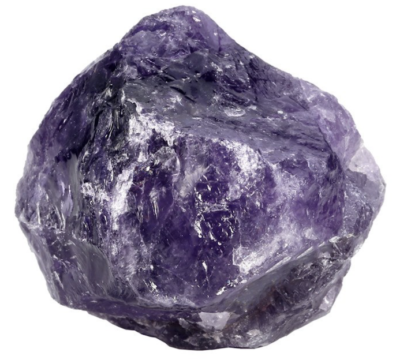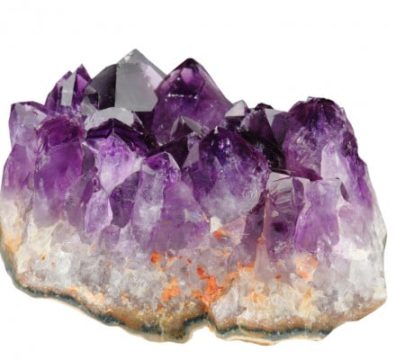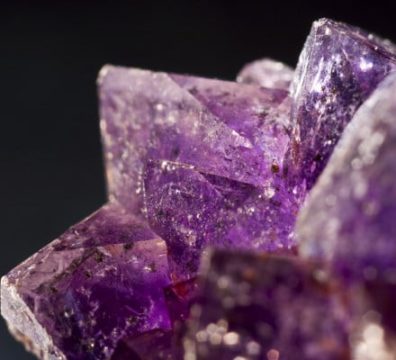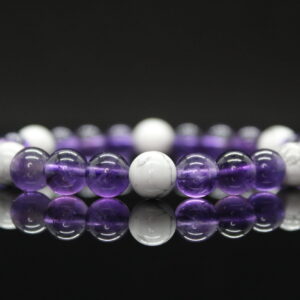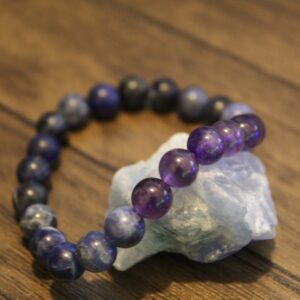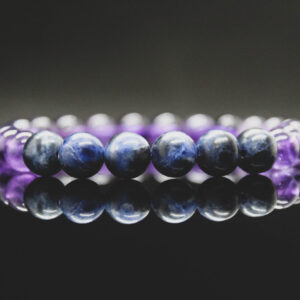Home | Crystal Guide | All Crystals | Amethyst
Amethyst Meaning & Properties
Intuition Creativity Manifestation
Introduction to Amethyst Crystals
Amethyst, with its vibrant shades of purple and a rich history dating back centuries, is a mesmerizing gemstone that has captivated people around the world. Formed deep within the Earth’s crust, amethyst crystals are renowned for their beauty, healing properties, and spiritual significance. This article delves into the enchanting world of amethyst crystals, exploring their formation, characteristics, and various colors and varieties. Discover the intriguing historical significance and mythology attached to amethyst, along with its healing and metaphysical properties. Additionally, gain insights into selecting and caring for amethyst crystals, explore their uses in jewelry and decor, and debunk popular myths surrounding this captivating gemstone. Join us on this captivating journey to unravel the secrets of amethyst crystals.
What is Amethyst?
Amethyst, my friends, is not just another pretty crystal to Instagram about. It’s a popular gemstone that has been capturing hearts for centuries (and no, it doesn’t come with a spellbook or magical powers, unfortunately). But what it lacks in mystical abilities, it more than makes up for with its stunning beauty and calming energy. Amethyst belongs to the quartz family and is known for its lovely purple color, ranging from light lavender to deep violet.
Significance of Amethyst
Now, you might be wondering, “Why should I care about a purple rock?” Well, buckle up, because amethyst has quite the reputation. Throughout history, it has been associated with qualities like peace, tranquility, and spiritual growth. Some people even believe that it can ward off negative energy and protect against bad vibes. So, if you’re in need of a little extra zen in your life, amethyst might just be your new BFF.
Formation and Characteristics of Amethyst
How is Amethyst Formed?
Okay, so how does this majestic gem come to be? Amethyst is formed deep within the Earth’s crust when hot magma cools down nice and slow. As the magma cools, it creates pockets where minerals start to form crystals. In the case of amethyst, it’s the iron impurities combined with natural radiation that give it that gorgeous purple hue. So, it’s like nature’s own little science experiment going on down there.
Physical Characteristics of Amethyst
Let’s talk about the physical attributes of amethyst, shall we? The first thing you’ll notice is its color, which can range from a delicate lilac to a regal purple fit for royalty. But don’t be fooled by its pretty exterior. Amethyst is a tough cookie with a hardness rating of 7 on the Mohs scale. In English, that means it can hold its own against scratches and everyday wear. So, feel free to wear your amethyst jewelry without worrying about it losing its sparkle.
Historical Significance and Mythology
Ancient Cultures and Amethyst
Amethyst has been admired by civilizations throughout the ages. The ancient Egyptians held it in high regard, using it in their jewelry and amulets. Meanwhile, the Greeks believed that wearing amethyst could prevent intoxication (cue the disappointed college students). They even had a legend that connected amethyst with the god of wine, Bacchus. Apparently, he got a little ticked off and decided to turn a young maiden into stone, hence the striking purple gem we know today.
Mythological Beliefs and Legends
Mythology lovers, listen up! Amethyst has a place in several fascinating legends. According to one story, the titan Rhea created amethyst by crying tears of sorrow. Her tears turned to stone when they fell upon the Earth, and voilà, amethyst was born. This tale just goes to show that even in ancient times, people found creative ways to explain the wonders of the natural world.
The Varieties and Colors of Amethyst
Types of Amethyst
Amethyst isn’t a one-size-fits-all kind of crystal. Oh no, my friend, it comes in various types to suit all tastes. From Chevron amethyst with its distinctive white zigzag pattern to Brandberg amethyst with its clear quartz inclusions, there’s a flavor for everyone. Each type brings its own unique energy and aesthetic to the table, making collecting amethyst an adventure in itself.
Color Variations and Meanings
Now, let’s dive into the wonderful world of amethyst colors. Besides its classic purple shade, amethyst also comes in delightful variations. From pale lavender to deep violet, each color carries its own special meaning. Lighter shades are often associated with peace, while darker tones symbolize strength and protection. So, whether you prefer a subtle pastel or a bold jewel tone, amethyst has got you covered. Oh, amethyst, you fascinating beauty! From its formation deep within the Earth to its rich historical background and vibrant range of colors, this crystal truly has it all. Next time you come across an amethyst, take a moment to appreciate its natural allure and maybe even let it bring a little peace and serenity into your life.
Healing and Metaphysical Properties of Amethyst
Overview of Healing Properties
Amethyst crystals are not just pretty to look at, they also pack a punch when it comes to healing properties. These gorgeous purple gems are believed to help with physical ailments such as headaches, insomnia, and even detoxification. They are also thought to promote a calm and clear mind, making them perfect for meditation and reducing stress.
Emotional and Spiritual Benefits
In addition to their physical healing properties, amethyst crystals are said to have powerful emotional and spiritual benefits. They are believed to promote emotional balance, helping to calm anxiety and relieve depression. Amethyst crystals are also thought to enhance spiritual growth and intuition, making them a popular choice for those seeking a deeper connection with the divine.
Chakra Association
Amethyst is closely associated with the crown chakra, which is located at the top of the head. This chakra is connected to our spirituality and higher consciousness. By working with amethyst crystals, it is believed that you can open and activate your crown chakra, allowing for a greater connection to your higher self and the divine.
How to Choose and Care for Amethyst Crystals
Selecting the Right Amethyst Crystal
When it comes to choosing an amethyst crystal, trust your intuition. Allow yourself to be drawn to the one that catches your eye or feels right in your hand. Each amethyst crystal has its own unique energy, so pick the one that resonates with you the most.
Caring for Amethyst
Caring for your amethyst crystals is a piece of cake. Just like any other crystal, they appreciate a little love and attention. To keep your amethyst looking its best, avoid exposing it to direct sunlight for long periods as this can cause fading. It’s also a good idea to cleanse your amethyst regularly to clear away any negative energy it may have absorbed. You can do this by rinsing it under running water or leaving it in the moonlight overnight to recharge.
Different Uses of Amethyst in Jewelry and Decor
Amethyst in Jewelry
Amethyst crystals are a popular choice for jewelry due to their stunning purple color. From dainty necklaces to statement rings, there’s an amethyst piece for everyone. Wearing amethyst jewelry not only adds a touch of elegance to your outfit, but it also allows you to carry the crystal’s healing energy with you wherever you go.
Amethyst in Home Decor
If you’re looking to add a touch of zen to your space, amethyst crystals make the perfect decor accent. Whether displayed as a cluster on a shelf or used as a paperweight on your desk, these crystals bring a calming and soothing energy to any room. Plus, they’re pretty to look at, so it’s a win-win!
Popular Amethyst Crystal Myths Debunked
Common Misconceptions about Amethyst
Let’s bust some amethyst myths, shall we? One common misconception is that amethyst crystals can only be purple. While purple is the most common color, amethyst can also appear in shades of pink, green, and even black. Another myth is that amethyst can only be found in large and expensive pieces. In reality, amethyst crystals come in various sizes and price ranges, making them accessible to all.
Separating Facts from Fiction
Now that we’ve cleared up some misconceptions, let’s separate fact from fiction. Amethyst crystals are not magical cure-alls, but they can certainly have a positive impact on our well-being. While there is no scientific evidence to support the metaphysical properties of crystals, many people find comfort and healing in their presence. Whether you believe in the power of amethyst or just enjoy their beauty, they can be a wonderful addition to your life.In conclusion, amethyst crystals are truly remarkable and continue to fascinate us with their beauty and mystique. Whether you are drawn to them for their stunning colors, their historical significance, or their healing properties, amethysts have a unique allure that transcends time. By understanding their formation, characteristics, and the various ways they can be used, you can fully appreciate the wonder and power of these magnificent gemstones. So, whether you choose to wear amethyst jewelry, incorporate it into your home decor, or simply keep it close for its positive energy, let the enchanting presence of amethyst crystals enhance your life and bring you joy.
Frequently Asked Questions (FAQ)
1. What is the meaning of the name “amethyst”?
Amethyst derives its name from the Greek word “amethystos,” which translates to “not drunken” or “sober.” This name reflects the ancient belief that wearing or possessing amethyst could prevent intoxication or drunkenness.
2. Can amethyst crystals help with sleep and relaxation?
Amethyst is often associated with promoting calmness and aiding in sleep and relaxation. Its soothing energy is believed to help alleviate stress, anxiety, and insomnia. Placing an amethyst crystal under your pillow or in your bedroom is a common practice to support restful sleep.
3. Are all amethyst crystals purple?
While purple is the most common color associated with amethyst, not all amethyst crystals are exclusively purple. Amethysts can range in color from pale lilac to deep violet, and some even exhibit hues of pink or blue. These variations in color are due to different mineral inclusions and impurities present during their formation.
4. How do I cleanse and recharge my amethyst crystal?
To cleanse and recharge your amethyst crystal, you can use various methods such as running it under cool water, placing it in sunlight or moonlight, or using other cleansing crystals like selenite or quartz. The specific method you choose depends on personal preference and the recommendations you resonate with. Remember to set your intention for the cleansing process to remove any negative energies and recharge the crystal with positive vibrations.

